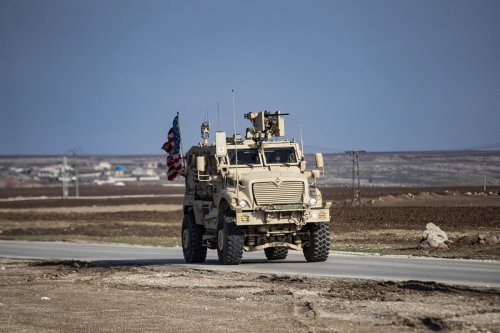The New Balance Of Power In The Middle East
During his visit to the Middle East in May, U.S. President Donald Trump did several things that few would have predicted months or even weeks earlier. One was his surprise meeting with Syria’s new leader, Ahmed al-Shara, and the subsequent lifting of U.S. sanctions on Syria, notwithstanding Shara’s history as a leader of a militant Islamist group. Another was his decision not to include Israel on the itinerary, despite his administration’s ongoing efforts to end the war in Gaza. The trip followed the administration’s decision in early May to sign a bilateral cease-fire with the Houthis in Yemen, without consulting or including Israel. Along with Trump’s initiation of direct talks with Iran—a step that Israel adamantly opposes but Arab leaders in the Persian Gulf welcomed and even helped facilitate—these developments suggest how much the regional balance of power has changed since Hamas’s October 7, 2023, attack on Israel.
The war in Gaza has altered the geopolitical landscape of the Middle East. In the years before the October 7 attack, Saudi Arabia, the United Arab Emirates (UAE), and other Gulf states shared with Israel the perception that Iran and its alliance of proxy forces were the region’s overriding threat. They supported the first Trump administration’s “maximum pressure” campaign on Tehran, and they began to normalize relations with Israel. Today, the situation has dramatically shifted. Twenty months into the war, Tehran appears far less of a threat to the Arab world. Meanwhile, Israel looks increasingly like a regional hegemon.
Amid these developments, Washington’s Arab allies and Israel are now in opposite camps on the merits of a new nuclear deal. Israel still sees a deal as a lifeline for the Islamic Republic and has been urging the Trump administration instead to take military action to destroy Iran’s nuclear facilities. The Gulf states, by contrast, dread a new and potentially uncontainable war on their doorsteps and view a diplomatic resolution with Tehran as vital to regional security and stability. They are also wary of creating a Middle East in which Israel has free rein—even in a future in which normalization with Israel can move forward. In their effort to achieve a new balance between Israel and Iran, the Gulf states have become primary players in Trump’s push for a new nuclear deal. Together, they aim to become the fulcrum of a reconfigured regional order.
To grasp the extent of the Gulf states’ shift on Iran, it is crucial to recall Saudi Arabia and the UAE’s reaction to the first U.S.-Iranian nuclear deal a decade ago. When Iran and the United States signed the Joint Comprehensive Plan of Action, or JCPOA, in July 2015, the Gulf states shared Israel’s concern that it would bolster Iran’s regional influence. At the time, the Arab world was still recovering from popular uprisings during the 2010–11 Arab Spring, which had toppled once powerful rulers and sparked civil wars in Libya, Syria, and Yemen. Iran had profited from the tumult, carving a sphere of influence stretching from the Arabian Peninsula to the Levant. In a speech before the U.S. Congress in March 2015, Israeli Prime Minister Benjamin Netanyahu warned, “Iran now dominates four Arab capitals— Baghdad, Damascus, Beirut, and Sanaa.” The Gulf Arab states, like Israel, worried that the United States, in its push for the nuclear accord, was ignoring the growing regional threat posed by the Islamic Republic and its proxies. The same month as Netanyahu’s speech, Saudi Arabia announced it was leading a military intervention in Yemen against the Houthis, the insurgent group that was expanding Iran’s sphere of influence into the Arabian Peninsula.
and Washington’s Gulf allies may have overstated the prospect of Iranian hegemony in the Middle East, but there was no denying that the turmoil in the Arab world had tilted the regional balance of power in Iran’s favor. To its Middle East detractors, the JCPOA was not just about Iran’s nuclear capabilities but also about Iran’s relative influence. According to the terms of the deal, Iran got sanctions relief just for agreeing to limit its nuclear program; it was not required to rein in its proxy forces in the region. As a result, the deal threatened to increase Iran’s sway even as it curbed the country’s pursuit of nuclear weapons. Arab states thus joined hands with Israel to underscore this flaw and used it in a high-profile effort to undermine the JCPOA. In addition to aggressively lobbying members of Congress—an offensive symbolized by Netanyahu’s 2015 speech—this effort included a public and media campaign against the deal.
During his first administration, Trump concurred with the deal’s critics. The United States unilaterally abandoned the JCPOA in 2018 and placed Iran under “maximum pressure” economic sanctions. At the time, the Trump administration expected that this pressure would weaken Iran and shrink its regional influence in favor of a new regional order centered on Israel
and Washington’s Arab allies. The administration promoted expanded Arab-Israeli security and intelligence cooperation, culminating in the 2020 Abraham Accords—the agreement that normalized relations between Israel and a series of Arab and North African states, including Bahrain and the UAE, and subsequently Morocco and Sudan. It also took a harder line toward Iran’s support for proxy forces across the region, to the point of making the highly unusual decision to assassinate Iranian General Qasem Soleimani, the powerful head of Iran’s Islamic Revolutionary Guard Corps, in Baghdad in 2020.
The tougher U.S. strategy toward Iran continued under President Joe Biden. Contrary to expectations, the Biden administration did not restore the JCPOA
and eschewed engaging with Iran—agreeing to talks only after Iran raised the stakes by accelerating its accumulation of highly enriched uranium. Biden’s focus, much like Trump’s, was instead on forging an Arab-Israeli axis. Normalization of relations between Israel and Saudi Arabia thus became the lodestar of Biden’s Middle East policy. Indeed, at the time of Hamas’s October 7 attack, the administration thought it was on the cusp of an Israeli-Saudi deal that would bring lasting peace to the region.
As events would soon make clear, that assumption was terribly misguided. The Trump-Biden strategy only aggravated regional tensions. Iran responded to U.S. pressure by expanding its nuclear program and its support for the Houthis in Yemen in their war with the Gulf states. It also began directly attacking U.S. and Gulf interests, most notably Saudi oil facilities, in 2019. Even before the October 7 attack, the Gulf states had lost confidence in Washington’s strategy. In March 2023, Saudi Arabia broke ranks to normalize ties with Iran—in a deal brokered by China. One immediate benefit was an end to Houthi attacks on Saudi Arabia and the UAE. The Gulf states remained committed to expanding ties with Israel, but maintaining a balance between Iran and Israel would prove difficult.
Then came Hamas’s attacks and Israel’s blistering war in Gaza, which derailed normalization between Israel and Saudi Arabia. A resurgent “axis of resistance,” backed by Iran—including Hezbollah in Lebanon and the Houthis in Yemen, who, along with Hamas saw the prospect of Israeli-Saudi normalization as an existential threat—was now at open war with Israel. The Biden administration assumed that this new regional conflict would strengthen the case for an Israel– Gulf state security alliance, but the Gulf states were loath to be dragged into that conflict. In January 2024, when Biden resolved to respond militarily to the Houthis’ attacks on international shipping in the Red Sea, Saudi Arabia and the UAE assiduously avoided getting involved, despite their years-long struggle against the group. Arab states also had to account for the growing anger among the Arab public about the treatment of the people of Gaza, which precluded any further tightening of Arab-Israeli security cooperation.
Then, in the fall of 2024, a series of Israeli successes turned the tide of the war. In late September, Israel eliminated Hezbollah’s top leadership, including the organization’s longtime leader, Hasan Nasrallah, in a targeted bomb
attack—a strike that followed on the heels of a successful undercover operation that decimated the group’s command-and-control structure using exploding pagers. The following month, Israeli forces killed Yahya Sinwar, the Hamas leader who had masterminded the October 7 attack. And in early December, the Syrian regime of Bashar al-Assad, a longtime close Iranian ally, collapsed. Meanwhile, dangerous exchanges of missiles and drones between Iran and Israel raised the stakes but also further dented Iran’s aura of power, with Israel claiming to have neutralized many of Iran’s air defenses.
By the end of the year, the axis of resistance had been diminished, and Tehran found itself largely cut off from the Levant. Even Iran’s defense of its homeland looked vulnerable. With Trump, a strong backer of Israel, poised to return to the White House, a confident Netanyahu government in Israel saw a rare opportunity to deal a decisive blow to Iran, destroying its nuclear facilities and devastating its economic infrastructure in an attack that would push the Islamic Republic to the brink.
Yet Trump has not followed the expected Israeli script. Worried that military strikes on Iran will pull the United States into a costly war, the president has thus far resisted Israeli pressure to dispense with diplomacy and wage open war on Iran. Instead, he has pushed for a new version of precisely the thing he repudiated during his first term: a nuclear deal. In doing so, he is backed by the Gulf states, which, despite their opposition to the earlier deal, also now favor diplomacy with Iran. Since Trump took office, Oman, Qatar, Saudi Arabia, and the UAE have all counseled against war and acted as intermediaries and mediators between Tehran and Washington. The most obvious reason for this shift is fear of what war in the Gulf would do to their economies. At a more fundamental level, Saudi Arabia and other Gulf states see a nuclear deal as central to achieving a new balance of power in the Middle East.
In part, Gulf support for an Iran deal has to do with Israel’s own changed position in the region. Even as it continues its offensive in Gaza, Israel has already begun to emerge triumphant, confident in its absolute military superiority, and ready to use it to assert domination over the Middle East. In addition to expanding its occupation of Gaza, which Israeli leaders have suggested could be put under indefinite military rule, Israel has been imposing its will on south Lebanon and is occupying and carrying out military incursions into large swaths of Syria. And now it wants to extend its victorious campaign in the Levant to the Gulf, with a military attack on Iran. In addition to provoking Iranian retaliation that could soon include targets on the Arabian Peninsula, such an attack could disrupt world energy supplies and cast doubt on the long-term viability of the economic boom in the Gulf.
Source: FOREIGN AFFAIRS (www. foreignaffairs.com) June 10, 2025.
You Might Be Interested In










